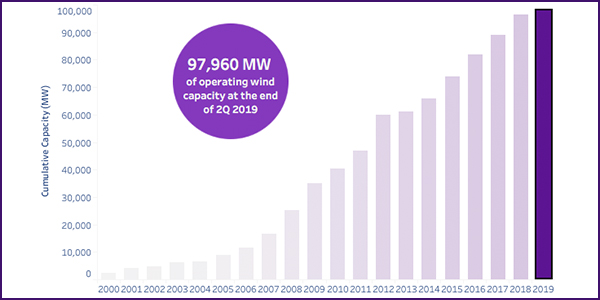By Rich Heidorn Jr.
Solar generation is continuing to accelerate, but onshore wind appears to be losing momentum outside ERCOT and Alberta, RTO officials told the NERC Operating Reliability Subcommittee on Wednesday.
Committee members discussed the growth of wind and solar generation following Committee Chair Chris Pilong’s observation that wind growth has plateaued in PJM while solar and batteries are “starting to ramp up.”
“There’s still wind coming online, maybe not at the velocity that it was in the previous few years, but there’s still some in the queue,” said Michael McMullen, MISO’s director of regional operations. “The solar is definitely picking up.”

Cumulative U.S. wind capacity | American Wind Energy Association
Lacy Skinner, assistant chief system operator for NYISO, said New York is seeing more behind-the-meter solar. “The last couple years, we [had] a rush [of wind]. We got about 1,700 MW of wind at one point in time. And then over the last couple years, we’ve only added another 150 [MW]. So, it has kind of slowed down.”
NYISO’s first battery project is in the testing stage. “I know there’s a bunch more in the bucket,” he said.
Alberta expects to add 600 MW of wind this year to its existing 1,400 MW with another 700 MW next year — nearly doubling its capacity. A 400-MW solar farm is expected for 2021, its largest installation yet.
ERCOT, with 22,000 MW of wind installed, is showing no signs of slowing down, said James E. Hartmann Jr., senior manager of system operations. “We still have a lot coming,” he said.
The Texas grid operator has about 2,000 MW of utility-scale solar, “and we have at least twice that much coming,” he said. ERCOT will be adding a five-minute solar forecast into its energy management system.

Solar power was responsible for half of the generating capacity added in the first quarter of 2019. | Solar Energy Industries Association
“One thing we’re seeing [with] these big utility-scale solar farms, whenever a big cloud will go over them, you’ll see almost an instant drop of the generation. Not as fast [as] a unit trip, but it ramps very fast.”
SPP did not report on its wind growth at the meeting. As of Jan. 1, wind nameplate capacity was almost 23% of the RTO’s total capacity. Wind produced almost a quarter of its electricity in 2018.
ISO-NE is adding about 50 MW of solar a month, said John Norden, the RTO’s director of operations. “Five years ago, there was no solar in New England. We’re over 3,000 MW now. Our average load is about 15,000 [MW], so it’s not insignificant for us. We definitely see the duck curve.”
Norden said the biggest change coming to the region’s generation mix will be offshore wind. The RTO is planning to send some of its engineers to the North Sea “to see how they did it” in preparation for its first large farm, the 800-MW Vineyard Wind project off Martha’s Vineyard and Nantucket.

Annual U.S. solar installations | Solar Energy Industries Association
He noted that the planned turbines will not be visible from land.
“If anybody followed the offshore programs in New England for the last couple decades, anything that could be seen from any landmass was killed. So, these are all over the horizon, and we suspect they will be built because they’re sponsored with state money.
“People are coming to us now [wanting] co-located batteries and solar farms and possibly wind farms included as a single asset. So, we’re trying to develop a product to dispatch those all together. And I think it will look like a battery when all is said and done.”



